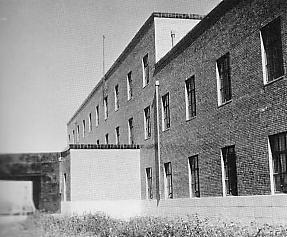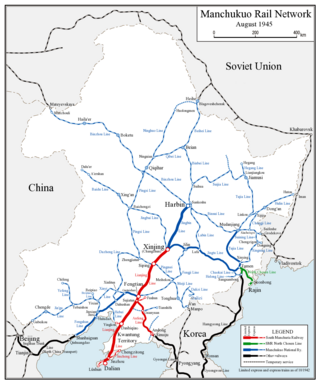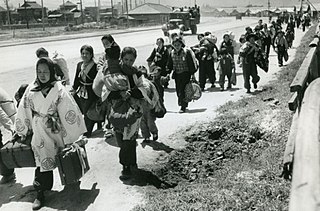
Manchukuo was a puppet state of the Empire of Japan in Northeast China that existed from 1932 until its dissolution in 1945. It was ostensibly founded as a republic, its territory consisting of the lands seized in the Japanese invasion of Manchuria; it was later declared to be a constitutional monarchy in 1934, though very little changed in the actual functioning of government. Manchukuo received limited diplomatic recognition, mostly from states aligned with the Axis powers, with its existence widely seen as illegitimate.

The Mukden incident was a false flag event staged by Japanese military personnel as a pretext for the 1931 Japanese invasion of Manchuria.
The following table shows comparative officer ranks of World War II, with the ranks of Allied powers, the major Axis powers and various other countries and co-belligerents during World War II.

Manchuria Aviation Company was the national airline of Manchukuo.

The Manchuria Airplane Manufacturing Company was an aircraft company in Manchukuo in the 1930s and 1940s, producing a variety of mostly military aircraft and aircraft components. It was named Manshū or Mansyuu in short.

The Manchukuo Imperial Army was the ground force of the military of the Manchukuo, a puppet state established by Imperial Japan in Manchuria, a region of northeastern China. The force was primarily used for fighting against Communist and Nationalist guerrillas in Manchukuo but also took part in battle against the Soviet Red Army on several occasions. It initially consisted of former National Revolutionary Army troops of the "Young Marshal" Zhang Xueliang who were recruited after the Japanese invasion of Manchuria en masse, but eventually expanded to include new volunteers and conscripts. The Imperial Army increased in size from about 111,000 troops in 1933 to an estimated strength of between 170,000 and 220,000 soldiers at its peak in 1945, being composed of Han Chinese, Manchus, Mongols, Koreans, Japanese, and White Russians. Throughout its existence the majority of its troops were considered to be mostly unreliable by their Japanese officers and advisers, due to poor training and low morale.
The National anthem of Manchukuo was one of the many national symbols of independence and sovereignty created to foster a sense of legitimacy for Manchukuo in both an effort to secure international diplomatic recognition and to foster a sense of nationalism among its inhabitants.

Manchukuo Film Association Corporation or Man'ei (滿映) was a Japanese film studio in Manchukuo during the 1930s and 1940s.

The flag of the Empire of Manchuria had a yellow field with four horizontal stripes of different colours in the upper-left corner. The colours of the flag were based on the colours on the Five Races Under One Union flags used by the Beiyang government, the Empire of China, and by the Fengtian clique. The flag was first established in Announcement of National Flag on 1 March 1932.

The Manchukuo Imperial Air Force was the air force of Manchukuo, a puppet state of Imperial Japan. The air force's predecessor was the Manchukuo Air Transport Company, a paramilitary airline formed in 1931, which undertook transport and reconnaissance missions for the Japanese military.

The Manchurian Industrial Development Company was an industrial conglomerate, or zaibatsu, in the Japanese-controlled Empire of Manchuria (Manchukuo), established at the instigation of the Imperial Japanese Army to further the industrialization of Manchukuo, and in particular, to make it self-sufficient in strategic heavy industries.

The Concordia Association was a political party in Manchukuo. Established to promote the ideals of Pan-Asianism and the creation of a multi-ethnic nation-state and to create a structure which would gradually replace military rule over Manchukuo with civilian control, the party was unable to fulfill its promise, and was eventually subverted into an instrument of totalitarian state-control by the Japanese Kwantung Army.

Dōwa Automotive Industries Co Ltd was a Manchukuo-based manufacturer of automobiles, trucks and armored cars. Its head office was in Mukden, the largest city of Manchukuo.

The Japan–Manchukuo Protocol was signed on 15 September 1932, between Japan and the state of Manchukuo. The Treaty confirmed the recognition by Japan of the Manchukuo state, following the Japanese invasion of Manchuria in 1931, and the establishment of a Manchurian state on 1 March 1932. The treaty also defined a mutual defence agreement, allowing Japanese troops to station in Manchukuo, and thereby effectively occupy the country.
The East Asian Games, also known as the Asian Development Games were multi-sport events organized by the Japan Association of Athletics Federations (JAAA). The games were meant to be a replacement to the cancelled 1938 Far Eastern Championship Games and 1940 Summer Olympics originally to be hosted by Japan, and also served as a propaganda tool for Japan.

The Manchukuo National Railway was the state-owned national railway company of Manchukuo. Generally called the "國線", it was controlled by the Manchukuo Ministry of Transportation and had its lines primarily in the central and northern parts of the country. In local newspapers it was simply referred to as "國鉄". It was built, operated and managed by the South Manchuria Railway, a state-owned national railway company of the Empire of Japan, of which the Kwantung Army frequently intervened in its affairs.

The Manshū Nichi-Nichi Shimbun was a Japanese-language newspaper owned by the South Manchuria Railway Company and printed from 3 November 1907 until Japan's defeat in the Second World War in 1945. Printed in Dairen, capital of the Japanese-controlled Kwantung Leased Territory, and from 1938 in Mukden, it was the most influential newspaper serving the growing Japanese settler population in northeastern China. In 1927, it merged with the rival Ryōtō Shimpō and was renamed the Manshū Nippō, before returning to its original name in 1935 following another merger with Dairen Shimbun, whereupon it gained a complete monopoly on Japanese-language news in what had become the Japanese puppet state of Manchukuo. In 1944, it briefly changed its name back to Manshū Nippō before going out of print in 1945 following Japan's defeat in the war and subsequent withdrawal from Manchuria.
The Manchukuo Police was the main law enforcement agency of Manchukuo in what is today China.

The Japanese settlers in Manchuria were the Japanese immigrants who came to Manchuria after the Russo-Japanese War and settled in zones of Japanese interests.

















































